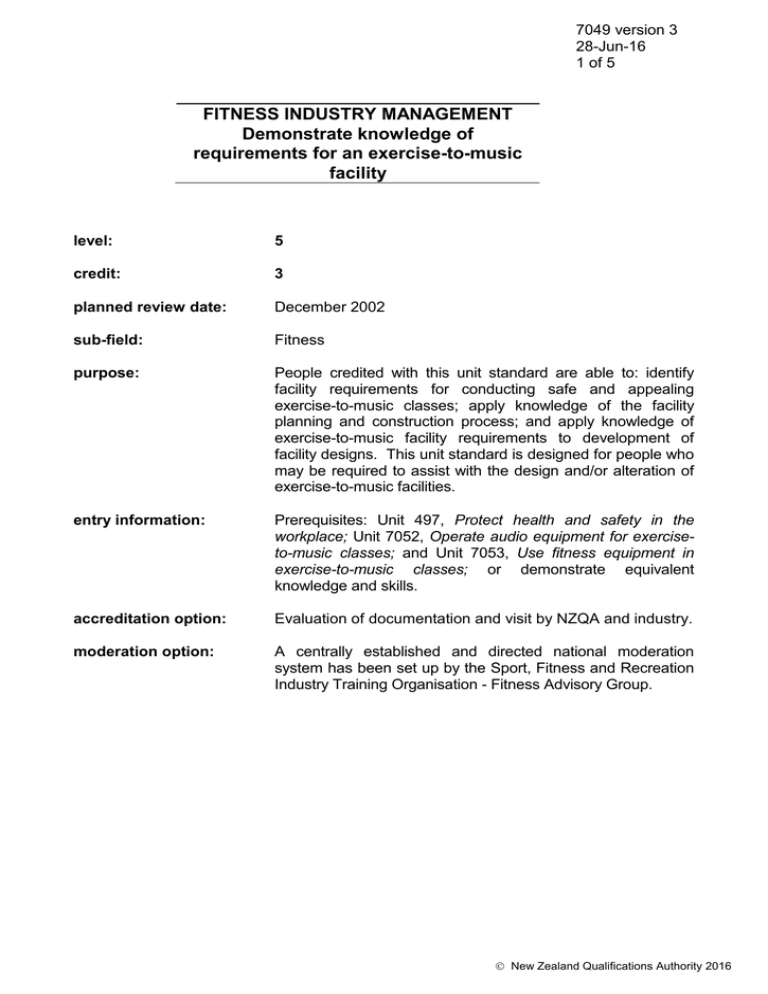FITNESS INDUSTRY MANAGEMENT Demonstrate knowledge of requirements for an exercise-to-music facility
advertisement

7049 version 3 28-Jun-16 1 of 5 FITNESS INDUSTRY MANAGEMENT Demonstrate knowledge of requirements for an exercise-to-music facility level: 5 credit: 3 planned review date: December 2002 sub-field: Fitness purpose: People credited with this unit standard are able to: identify facility requirements for conducting safe and appealing exercise-to-music classes; apply knowledge of the facility planning and construction process; and apply knowledge of exercise-to-music facility requirements to development of facility designs. This unit standard is designed for people who may be required to assist with the design and/or alteration of exercise-to-music facilities. entry information: Prerequisites: Unit 497, Protect health and safety in the workplace; Unit 7052, Operate audio equipment for exerciseto-music classes; and Unit 7053, Use fitness equipment in exercise-to-music classes; or demonstrate equivalent knowledge and skills. accreditation option: Evaluation of documentation and visit by NZQA and industry. moderation option: A centrally established and directed national moderation system has been set up by the Sport, Fitness and Recreation Industry Training Organisation - Fitness Advisory Group. New Zealand Qualifications Authority 2016 7049 version 3 28-Jun-16 2 of 5 FITNESS INDUSTRY MANAGEMENT Demonstrate knowledge of requirements for an exercise-to-music facility special notes: 1 Competence in this unit standard may be demonstrated in simulated situations related to an existing fitness and/or recreation facility or enterprise. If this unit standard is being assessed in an on-job situation then the references to simulated situations may be considered redundant except in respect of emergency procedures. 2 Competence in this unit standard requires knowledge of the hierarchy of controls outlined in the Health and Safety in Employment Act 1992 (HSE): elimination of significant hazards; isolation of significant hazards when elimination is not possible; and minimisation of significant hazards where elimination and isolation are not possible. 3 Competence in this unit standard requires knowledge of relevant provisions of current accident compensation legislation as in the Accident Rehabilitation and Compensation Insurance Act 1992 (ARCI). New Zealand Qualifications Authority 2016 7049 version 3 28-Jun-16 3 of 5 FITNESS INDUSTRY MANAGEMENT Demonstrate knowledge of requirements for an exercise-to-music facility Elements and Performance Criteria element 1 Identify facility requirements for conducting safe and appealing exercise-to-music classes. performance criteria 1.1 Facility requirements are described in terms of safety for users. Range: 1.2 users - clients, visitors, exercise-to-music staff, cleaners, repair and maintenance people; safety factors include - HSE guidelines, exercise space, floor construction and covering (including stage), stage size and height, access (to centre, to areas within centre), emergency egress, equipment storage, signage (type, prominence), glass protection, ventilation, audio equipment set-up (amplifier power, speaker power, microphone effectiveness). Facility style features are described in terms of benefits to clients. Range: style features include - convenience of use, access (to changing facilities, staff, reception), ventilation, floor covering, space, stage height and placement, colour, appearance of signage, placing of mirrors, pictures and/or posters, decorative features. New Zealand Qualifications Authority 2016 7049 version 3 28-Jun-16 4 of 5 FITNESS INDUSTRY MANAGEMENT Demonstrate knowledge of requirements for an exercise-to-music facility element 2 Apply knowledge of the facility planning and construction process. performance criteria 2.1 Aspects of the facility planning and construction process are described in terms of sequence, timing, and cost. Range: 2.2 aspects can include - phases (planning, design, construction), timeline, roles (operator, architect, consultants, interior designer, builder, subcontractor, inspector), fitness enterprise involvement, outcomes. Analysis of facility planning and establishes strategy for timing and type of input from fitness professionals. element 3 Apply knowledge of exercise-to-music facility requirements to development of facility designs. performance criteria 3.1 Communication with management, architects, builders meets their needs in respect of timeliness, content, and completeness of information. 3.2 Interpretation of safety requirements and client preferences is carried out within project constraints. Range: budget constraints, constraints. physical constraints, projected usage New Zealand Qualifications Authority 2016 7049 version 3 28-Jun-16 5 of 5 FITNESS INDUSTRY MANAGEMENT Demonstrate knowledge of requirements for an exercise-to-music facility 3.3 Building designs and layouts are analysed in terms of convenience and efficiency for business operation and client use. Range: operation and use includes - traffic flows, waiting areas, storage areas, space allocation by type of use (exercise-to-music, changing, individual, resistance training, circuit training, fitness assessment), ventilation, stage location, audio equipment set-up. Comments to: Sport, Fitness and Recreation Industry Training Organisation - Fitness Advisory Group Unit Standard Revision PO Box 160 WELLINGTON by December 2002. Please Note: Providers must be accredited by the Qualifications Authority before they can offer programmes of education and training assessed against unit standards. Accredited providers assessing against unit standards must engage with the moderation system that applies to those unit standards. [Please refer to relevant Plan ref: 0069] New Zealand Qualifications Authority 2016


